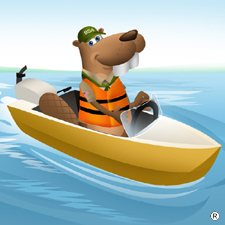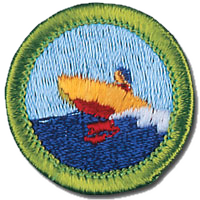Motorboating


Resources
- Motorboating Merit Badge Pamphlet
- Motorboating Merit Badge Workbook
- Scoutmaster Bucky's Merit Badge Advancement Quick Reference
Motorboating Requirements
Current Scouts BSA requirements
as of January 6, 2026
as of January 6, 2026
1.
Do the following:
a.
Discuss with your counselor the following hazards you might encounter
while motorboating: flammable fuel; carbon monoxide; propellers;
collisions; falls overboard; capsize; running aground. Explain what
you should do to anticipate, prevent, mitigate and respond to these
hazards.
b.
Explain first aid for injuries or illnesses that could occur while
motorboating, including hypothermia, heat reactions, dehydration,
motion sickness, bug bites, blisters.
c.
Discuss the Scouting America Safety Afloat policy. Tell how it
applies to motorboating activities.
2.
Do the following:
a.
Before doing requirement 5, successfully complete the Scouting America
swimmer test.
Note: See the Swimming merit
badge pamphlet for details about the Scouting America swimmer test.
b.
Name the different types of personal flotation devices (PFDs), and
explain when each type should be used. Show how to choose and properly
fit a PFD.
3.
Do the following:
a.
Explain inboard, outboard, and inboard/outboard motors, and the uses
and advantages of each.
b.
Explain the safety procedures and precautions involving handling fuel
and engine servicing, and equipment storage and placement.
c.
Explain how to winterize a boat motor and tell why this procedure is
necessary.
d.
Explain the safety procedures and precautions involving swimmers and
skiers in the water, passenger positions underway, and boat wakes.
4.
Show you know safety guidelines for motorboating by doing the following:
a.
Review how each item of the Scouting America Safety Afloat policy
applies, including checking the weather prior to and during time on the
water, confirming all required equipment is present and functional, and
following a float plan.
b.
Explain the rules or laws that apply to recreational boating in your
area or state. Have a permit to operate a motorboat, if required by the
laws of your state. Discuss how you would find information regarding
the boating laws in different states.
c.
Discuss how hazards of weather and heavy water conditions can affect
safety and performance in motorboating.
d.
Promise that you will follow Scouting America Safety Afloat guidelines.
Explain the meaning of each point.
e.
Explain and show the correct use of equipment required by both state
and federal regulations to be carried aboard a motorboat.
f.
Explain federal and state rules for a ventilation system, and tell why
these rules are required
g.
Explain the use of lights (sight signals) and sound signals on
motorboats.
h.
Discuss the common types of anchors used in motorboating and under
what conditions each would be preferred. Explain proper anchoring
techniques.
5.
With your counselor or other adults on board, demonstrate proper
boat-handling procedures and skills by doing the following:
a.
Board and assist others in boarding. Confirm that all passengers on
board are wearing properly fitted life jackets.
b.
Fuel the boat and complete a safety check.
c.
If equipped, attach the engine cut-off switch link and safely start the
motor. Get underway from dockside or from a beach launch.
d.
Run a course for at least a mile, showing procedures for overtaking and
passing slower vessels, yielding right-of-way, passing oncoming
traffic, making turns, reversing direction, and using navigation aids.
e.
Stop and secure the boat in position on the open water using anchors.
Raise and stow the anchor and get underway.
f.
Land or dock the boat, disembark, and assist others in doing the same.
g.
Moor, dock, or beach the boat and secure all gear.
h.
Demonstrate knots used in boating: cleating hitch, bowline, clove
hitch, anchor bend, sheet bend.